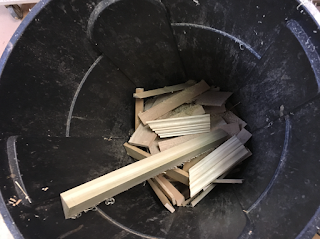I became aware of hollows and rounds as a means to an end: the ability to create an infinite number of options. I was attracted first to the ability to make what I may want, unbridled from my selection of router bits or Woodcraft's.
This beadstead that I am highlighting hopefully illustrates this idea.
Hollows, rounds and the accompanying few planes offer you, the end-user, infinity. They offer you choice and they offer speed for short lengths. They never inspired me, however, to get rid of my machinery because machines can speed up the process.
Last we left this moulding we had transferred the layout lines onto our block of wood.
From here I move to machines. First, the bandsaw:
The next step is to create a series of rabbets. As discussed previously on this blog, rabbets serve three purposes: removing the bulk of material with the edge that easiest to maintain, creating a series of chutes for the plane to ride in while serving as a substitute for a fence, and creating a series of depth gauges. (More on these in the past and in the future.)
I added most of my rabbets with a tablesaw. In this case I added the large chamfer on the bandsaw at 45 degrees, so I tipped my tablesaw blade over to 45.
I don't spend time being too perfect here. I just get it really close and then clean it up with a rabbet plane.
Making these rabbets with a snipes bill and rabbet plane is, of course, a straight forward process for you idealistic hand tool only guys. Lord nows I've made plenty myself. I just prefer the tablesaw here.
(Note: if you rely upon the fence and depth stop of a moving fillester or other similar plane than you will not be able to make this series of rabbets. You will eventually lose the surfaces upon which the fence and/or depth stop register.)
We have yet to use a profile plane, but we are nearly done. Getting to the above product I often estimate as being 70-80% or the work.
Do you see? It's that quick
It's done!
Again, the final product:
The final resting place:
And a hint at the options and final solutions for you Hand Tool Never guys:
Enjoy sacrificing, sanding and/or waiting weeks for delivery!













This comment has been removed by a blog administrator.
ReplyDelete